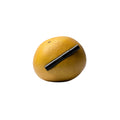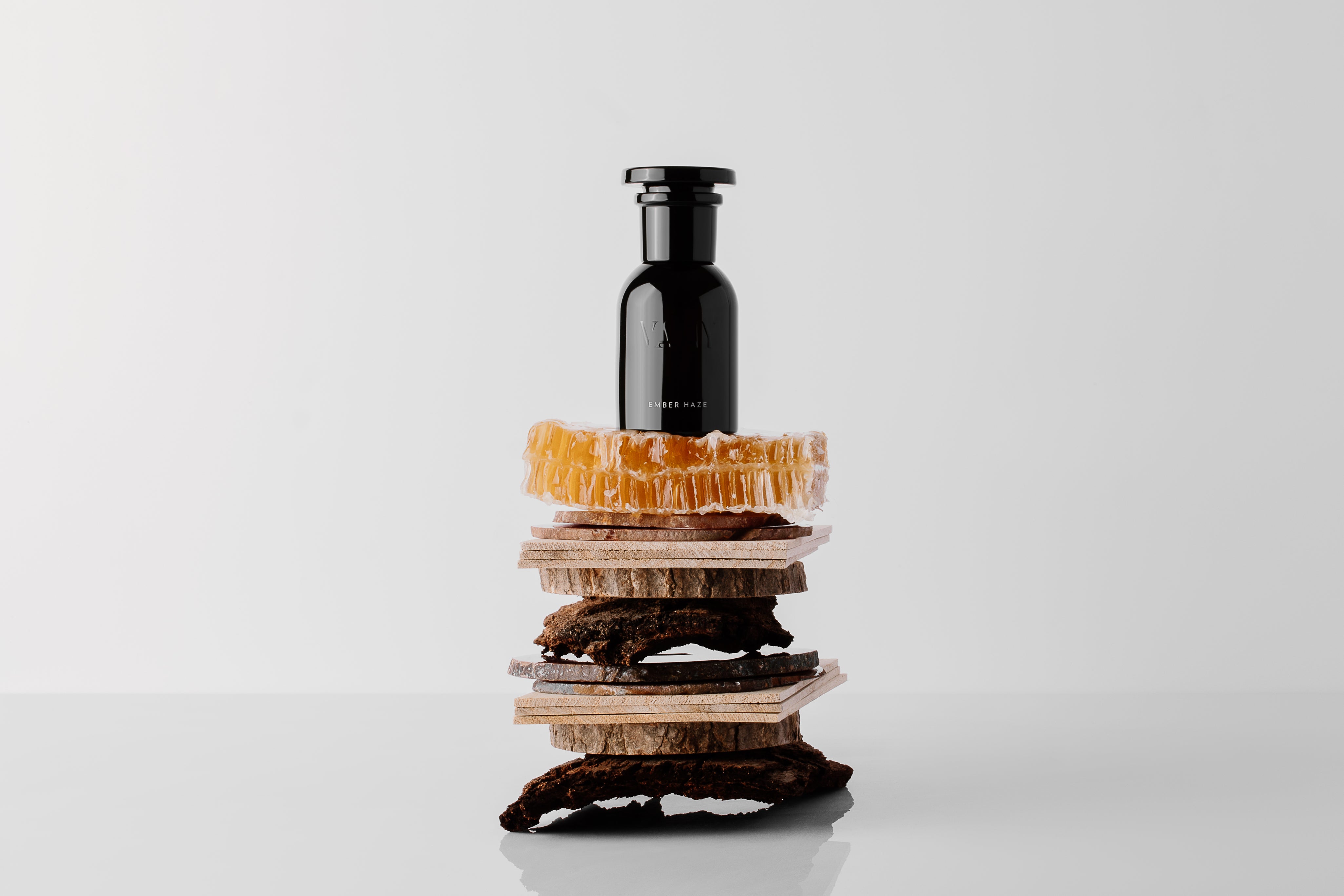Our 'Free From' Promise is a list of ingredients that we will never use in our products. This includes the two most common fragrance ingredients: synthetic fragrance and denatured alcohol, along with the over 1,400 chemicals banned or restricted for use in personal care products in the European Union plus additional chemicals screened by VAHY and found to be of concern.
-
There are no synthetics in VAHY products.
All VAHY products are made with 100% natural, organic and premium ingredients, and without synthetic chemicals.The word "fragrance", "parfum", “perfume” or “aroma” on the product label of fragrances and personal care products represents an undisclosed mixture of various synthetic scent chemicals and ingredients used as fragrance dispersants such as diethyl phthalate. (EWG)
According to the International Fragrance Association, there are more than 3,500 fragrance chemicals in use today. And exposure to some of these substances can lead to a wide range of health problems.
But companies aren’t required to disclose the individual ingredients that make up a product's particular fragrance concoction.
Fragrance chemicals aren’t benign – exposure to them can lead to a range of health problems. They can disrupt the hormone system. Some are phthalates, which can harm the reproductive system. Another fragrance chemical, styrene, is linked to cancer. And fragrance chemicals can also cause allergic reactions in kids and adults.
Fragrance chemicals are also bad for the environment: Chemical vapors in fragrance, called volatile organic compounds, can cause ozone pollution and form fine particulates, according to one study. (EWG)
-
There are no petrochemicals in VAHY products.
All VAHY products are made with 100% natural ingredients, and without toxic petrochemicals.Makers of popular perfumes, colognes and body sprays market their scents with terms like “floral,” “exotic,” or “musky,” but they don’t disclose that many scents are actually a complex cocktail of natural essences and synthetic chemicals – often petrochemicals. Laboratory tests
commissioned by the Campaign for Safe Cosmetics and analyzed by Environmental Working Group revealed 38 secret chemicals in 17 name brand fragrance products. (EWG)
The average fragrance product tested contained 14 secret chemicals not listed on the label. Among them are chemicals associated with hormone disruption and allergic reactions, and many substances that have not been assessed for safety in personal care products.
Also in the ranks of undisclosed ingredients are chemicals with troubling hazardous properties or with a propensity to accumulate in human tissues. These include diethyl phthalate, a chemical found in 97 percent of Americans (Silva 2004) and linked to sperm damage in human epidemiological studies (Swan 2008), and musk ketone, a synthetic fragrance ingredient that concentrates in human fat tissue and breast milk (Hutter 2009; Reiner 2007).
-
There are no forever chemicals in VAHY products.
All VAHY products are made with 100% natural ingredients, and without toxic forever chemicals.EWG’s Skin Deep® cosmetics database contains hundreds of fragrance products made with ingredients we consider to be highly hazardous, such as the toxic “forever chemicals” known as PFAS, artificial coloring, preservatives and lilial. (EWG)
-
There are no carcinogens or synthetic musks in VAHY products.
What is a carcinogen?
Carcinogen: A substance capable of causing cancer in living tissue.
Which synthetic fragrance ingredients are carcinogenic?
One of the key carcinogenic ingredients in synthetic fragrance is Synthetic Musk (Musk Ketone, Polycyclic Musks; Galaxolide, Cashmeran and Tonalide).
Alarmingly, the Environmental Working Group (EWG) found these ingredients in the majority of synthetic fragrances it tested in a major study on fragrance.
Musk Ketone (a member of the nitro musks family) is a synthetic fragrance ingredient that concentrates in human fat tissue and breast milk. (Hutter 2009; Reiner 2007)
It is widely used in the perfume and scented body care industry and is one of the last synthetic musks left that hasn’t yet been prohibited by IFRA.
According to the EWG, Musk Ketone has scientific links to cell system toxicity, hormone disruption, reproductive and development abnormalities as well as bio accumulation. (Meaning it accumulates in your body over time as it does not break down.)
High levels of synthetic Musk Ketone in women has also been scientifically linked to gynaecological abnormalities including compromised fertility. (Elsenhardt 2001)
Further, studies have found that breast cancer cells proliferated when they came into contact with Musk Ketone chemicals. (Bitsch 2002)
A recent EWG study found Galaxolide and Tonalide, two synthetic musks, in the cord blood of newborn babies (EWG 2009). Both musks contaminate people and the environment worldwide, and have been associated with toxicity to the endocrine system. (Van der Burg 2008)
Tonalide has also been identified as a photosensitizer, a chemical that becomes more toxic when exposed to sunlight on the skin. (EU 2008)
-
There are no hormone disruptors in VAHY products.
All VAHY products are made with 100% natural ingredients, and without hormone disrupting chemical ingredients.The EWG found an average of four hormone disrupting synthetic chemicals in each synthetic fragrance they tested. These chemicals either mimic estrogen or have thyroid effects. (EWG)
The greatest concern is that these chemicals, through their ability to mimic or disrupt natural estrogen, testosterone and thyroid pathways, may impair basic body functions like tissue growth and repair that are normally regulated by natural hormone signaling. (Soto 2009)
Recent research has also clearly demonstrated that even at low doses, exposure to hormonal disruptors during susceptible periods can have drastic consequences for health later in life.
Scientists are especially concerned about the impact of hormone-disrupting chemicals during critical windows of development, such as fetal development. (Breast Cancer Fund 2008)
Further, depending on the dose and timing, exposure to hormone disruptors has been linked to a wide range of health problems (Heindel 2009), including an increased risk of cancer, especially breast (Breast Cancer Fund 2008) and prostate (Prins 2008) cancers; reproductive toxicity and effects on the developing fetus; and predisposition to metabolic disease such as thyroid problems (Jugan 2010) or obesity (Hotchkiss 2008).
-
There are no animal derived ingredients in VAHY products, nor do we (or will we ever) test on animals.
There are many animal derived ingredients that are widely used in perfumery. As a PETA certified vegan and cruelty free brand, you will never find any animal derived ingredients in our products, and we will never test on animals.
-
There are no phthalates in VAHY products.
All VAHY products are made with 100% natural ingredients, and without hormone disrupting chemical ingredients.Phthalates are a class of endocrine-disrupting chemicals. They are found in many consumer products, including paint, plastics, fragrance and personal care products, such as nail polish.
Phthalates disrupt the hormone system by increasing the production of some hormones, decreasing the production of others and interfering with hormone signaling which can cause health problems.
Some of the health harms associated with phthalates are changes to fertility, early puberty and risk of low birth weight, obesity, diabetes, impacts to the immune system, cardiovascular and respiratory problems, some cancers and neurological and behavioral problems.
Children, infants and the growing fetus are especially vulnerable, since they’re still developing. (EWG)
-
There are no parabens in VAHY products.
All VAHY products are made with 100% natural ingredients, and without carcinogenic, hormone disrupting chemical ingredients.Parabens are a group of chemicals widely used as artificial preservatives in cosmetic and body care products since the 1920s. Since cosmetics contain ingredients that can biodegrade, these chemicals are added to prevent and reduce the growth of harmful bacteria and mold, increasing the shelf life of the product.
The concern with these chemicals is that scientific studies suggest that parabens can disrupt hormones in the body and harm fertility and reproductive organs, affect birth outcomes, and increase the risk of cancer. They can also cause skin irritation. Moreover, studies have detected parabens in nearly all urine samples taken from adults in the U.S., regardless of demographic (Ye 2006).
Given the endocrine disruption capacity and documented female and male reproductive harm, coupled with the potential for repeated lifelong exposure, it is clear that long-chain parabens (isobutyl-, butyl-, isopropyl- and propylparaben) should not be used in personal care or cosmetic products. (EWG)
-
There is no denatured alcohol in VAHY products.
All VAHY products are made with 100% natural ingredients, and without petrochemicals.Commonly used as the ‘base’ of commercially made perfumes, petroleum derived specially denatured alcohol (SD, SDA) is a mixture of ethanol with a denaturing agent (such as tert-butyl alcohol and denatonium benzonate, or commonly known as Bitrex).
Tert-butyl alcohol is irritating to the skin and eyes, while ethanol is considered broadly toxic and linked to birth defects following excessive oral ingestion. Though not currently listed on EWG’s Skin Deep Restricted or Unacceptable Lists, ethanol is considered a volatile organic compound by the National Pollutant Inventory and repeated contact can dry the skin resulting in the skin cracking, peeling and itching (not great for those with sensitive skin, that’s for sure). (EWG andAustralian Government Department of Climate Change, Energy, the Environment and Water)
At VAHY, we use organic sugarcane alcohol as the base for our perfumes. Sugarcane alcohol is derived from cane sugar, grown without any pesticides or fertilisers.
-
Formaldehyde is a preservative antimicrobal which is used in some fragrances. It is associated with asthma, neurotoxicity and developmental toxicity and it is a carcinogen.




